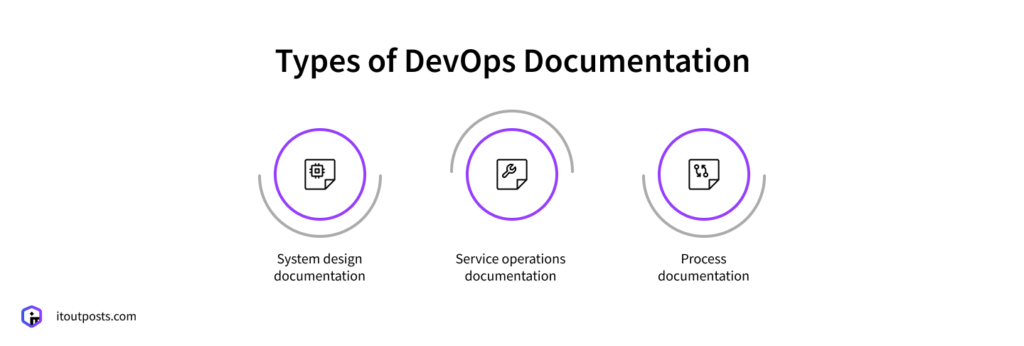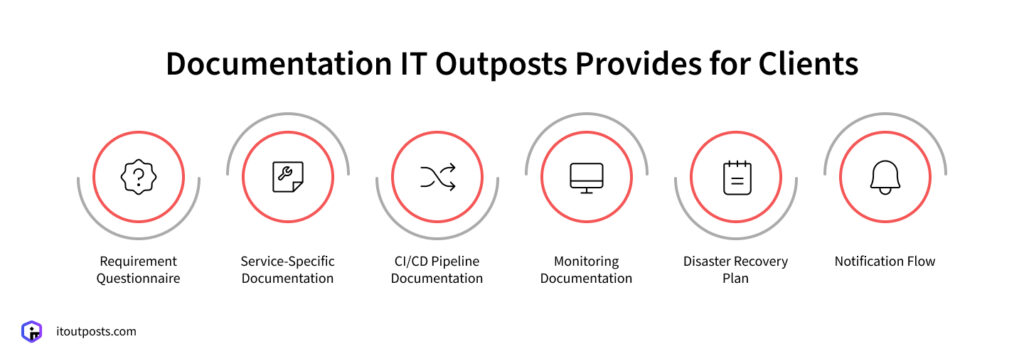Contents
Working with external DevOps service providers makes perfect sense for many businesses. They take care of your technical setup while you focus on your core products.
Maybe they’re just configuring specific systems before passing the reins to your in-house team. Or perhaps you partner with external DevOps providers until you’re ready to build your own team from scratch.
All these approaches work well. But when the day your cooperation ends comes, your team will need to maintain the infrastructure on their own. And this is when DevOps documentation proves its true worth.
In this article, we’ll share why clear, detailed documentation is so important and what types of documentation you should expect from your DevOps contractor.
What Is DevOps Documentation?
DevOps documentation is a complete guide to your infrastructure. It explains how to understand, maintain, and fix your technical systems and covers aspects such as deployment processes, monitoring setup, and recovery procedures.
When outside DevOps teams put together this kind of documentation, it should be useful not just for their team but for yours, too. Its goal is to make handovers smooth and avoid that annoying situation where only one person knows all the ins and outs of your systems.
DevOps documentation comes in different formats. You’ll see interactive wikis, inline code comments, automated runbooks, and knowledge bases. Some docs are stored right next to the code in repositories. Other parts exist in team collaboration tools like Confluence or Notion. Whatever the format is, everything must be accessible and easy to update.
Why Is DevOps Documentation Critical?
When your DevOps partner finalizes their work yet doesn’t provide you with detailed documentation, you’re basically given the keys to your infrastructure with no manual. This can lead to wasted time as you have to solve the same problems again and again, inability to make changes without breaking dependent services, security risks nobody’s aware of, longer downtime when systems break, and many other issues.

That’s what makes your documentation one of the most valuable assets when it comes to ensuring your systems perform smoothly in the long run and can be scaled easily.
It’s Your Insurance Policy
Your DevOps partner’s knowledge about your systems shouldn’t walk out the door with them. Good documentation means their expertise stays behind even when they don’t.
Faster Problem Solving When Minutes Count
Systems tend to break, and usually they do at the worst possible moment. And Murphy’s Law dictates they will break right after you end cooperation with your DevOps service provider. When your team has documentation to refer to in such cases, they have a clear plan to follow and don’t have to guess how to fix these problems.
Bringing New Team Members Up to Speed
You’ll also need to quickly onboard people who may be new to your projects. Without documentation, each new hire will have to spend weeks or even months just figuring out how things work. But with clear docs, they can become productive within days.
Consistency You Can Count On
When the original builders are gone, maintaining consistent operations can become more challenging without documentation. As it also ensures everyone follows the same steps for deployments, updates, and maintenance.
This is how you can prevent a decline in quality that often happens during such transitions. After all, your systems must work the same way regardless of who maintains them.
Making Smart Decisions About Your Infrastructure
After your partner leaves, you’ll also need to make ongoing decisions about your infrastructure. Should you upgrade your database? Migrate to a new cloud service?
Without knowing why systems were built the way they are, you risk not taking into account crucial dependencies and making changes that could break important functionality. But documentation is your context that eventually lets you make knowledgeable, safer choices.
Types of DevOps Documentation
While the exact documents may differ from project to project, here are some of the basic types you can expect from your DevOps contractor:

- System design documentation. This is the big picture of what you have and how it’s all connected. Infrastructure docs list all your system components and explain how to use them correctly. This information is especially handy when you need to scale or modify your setup.
- Service operations documentation. These are the how-to guides your team needs when your DevOps partner isn’t around to help or when you decide to deploy infrastructure yourself. How do you connect to the infrastructure? How do you access clusters? Where do you find logs? How do you restart pods? You should have these answers ready for each service in your environment.
- Process documentation. These are the workflows that keep your system running smoothly. They include your CI/CD pipeline details, monitoring and notification procedures, disaster recovery plan, and change management process.
Documentation IT Outposts Provides for Clients
When we work with our clients, our main goal is to make sure they fully understand everything we’ve built. Here’s the documentation package that comes with our DevOps services.

Requirement Questionnaire
While not always considered a standard part of DevOps documentation, a detailed questionnaire about your technical environment is what we usually begin with. This helps us understand your current setup and the challenges that must be prioritized.
The answers to the questionnaire serve as a starting point for our team. Some of the typical questions are:
- Whether you use containers or virtual machines
- Whether you run on AWS, Azure, or on-premises
- Whether you have all the environments in place: dev, staging, and prod
- Whether you have a full-fledged CI/CD pipeline
- Whether you need help with specific regulatory compliance
- Whether you already have any documentation for your current systems
- And, overall, how mature your DevOps practice is
- The questionnaire also becomes our shared reference point throughout our work together.
You can take part in a similar survey on our website. Check out our DevOps Implementation Review to identify areas for growth and detect any weaknesses in your infrastructure.
Service-Specific Documentation
Each service has its own straightforward guide written in plain language. We walk you through the exact steps to connect to your Kubernetes clusters, restart pods whenever it’s necessary, and more.
CI/CD Pipeline Documentation
Our team details your specific setup, explains what triggers each build, what tests are required at each stage, and how approval processes work.
Monitoring Documentation
We document how to use your specific DevOps monitoring tools, whether it’s Prometheus, Datadog, or another solution, and show how to access dashboards, interpret key metrics, and search logs.
Disaster Recovery Plan
Outages can happen unexpectedly, and clear recovery documents are lifesavers in this case. A disaster recovery plan covers database failures, network problems, etc.
We include details on potential data loss scenarios for your critical systems and easy-to-follow steps when such scenarios do occur. Our team also lists contact information for the right people so you know who to reach out to when urgent action is needed.
Notification Flow
We document who is notified about different kinds of issues and which channels alerts are sent to, as well as specify escalation paths when the main responders are unavailable.
GitFlow Strategy
While development teams usually handle Git workflows, some projects may lack structured processes, and we often offer to structure them. Our team documents the exact strategy your team will follow in Git.
Conclusion
Documentation is often the last item on the DevOps checklist. It’s easy to postpone until “later.” At IT Outposts, every system we build comes with comprehensive documentation that transfers knowledge to your team. And we document as we build and structure information for real-world use. This ensures nothing gets forgotten or oversimplified in the rush to complete a project.
If you’re looking for a reliable DevOps partner who can deliver a ready-to-use infrastructure with detailed documentation, consider IT Outposts and our offering, AMIX.
You’ll receive a pre-built setup with 20+ professionally configured and integrated tools that handles 10x growth at a fixed price.
Whether you prefer to deploy the infrastructure independently or want our assistance, we provide setup guidelines and all the necessary documentation for easy implementation.
Explore AMIX and contact us today to find out more about the benefits our service has for your fast time to market!

I am an IT professional with over 10 years of experience. My career trajectory is closely tied to strategic business development, sales expansion, and the structuring of marketing strategies.
Throughout my journey, I have successfully executed and applied numerous strategic approaches that have driven business growth and fortified competitive positions. An integral part of my experience lies in effective business process management, which, in turn, facilitated the adept coordination of cross-functional teams and the attainment of remarkable outcomes.
I take pride in my contributions to the IT sector’s advancement and look forward to exchanging experiences and ideas with professionals who share my passion for innovation and success.